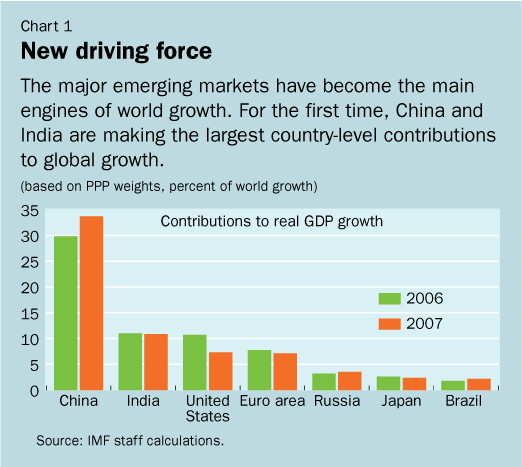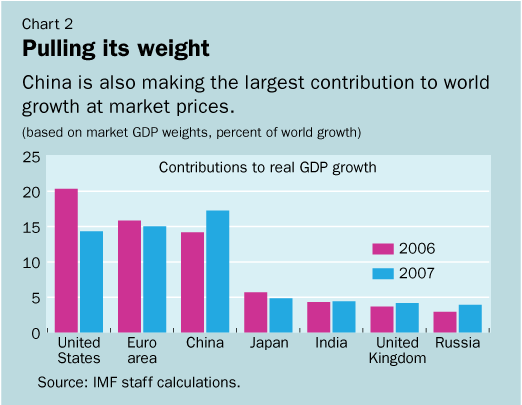
Typical street scene in Santa Ana, El Salvador. (Photo: iStock)
IMF Survey: Emerging Markets Main Engine of Growth
October 17, 2007
- Emerging markets China, India are for first time largest drivers of world growth
- Strong emerging markets growth due to sound policies, benign external conditions
- More financial turbulence could disrupt financial flows to emerging markets
China is now the single most important contributor to world growth, in terms of both market and purchasing-power-parity (PPP) exchange rates (see Charts 1 and 2).

Steelworks at Changzhi, China: sustained high growth makes China single most important contributor to world growth (photo: Reuters)
WORLD GROWTH LOCOMOTIVES
Its economy continues to grow at breakneck speed, turning it into a driving force in the global economy.

Market exchange rates are those prevailing in the foreign exchange market, while the PPP exchange rate is defined as the rate at which the currency of one country needs to be converted into that of another country so as to be able to purchase the same amount of goods and services in each country. Use of PPP exchange rates gives a greater weight to emerging market economies in the global growth aggregates.

China's economy gained further momentum in 2007, growing at 11½ percent, and is expected to grow by 10 percent in 2008. Other emerging markets are also growing strongly. India continued to grow at more than 9 percent in 2007, and Russia grew by almost 8 percent.
In fact, these three countries alone accounted for more than one-half of global growth over the past year. Other emerging market and developing countries have also maintained robust expansions. Rapid growth in these countries counterbalanced continued moderate growth in the United States (see "IMF Forecasts Slower World Growth in 2008").
Looking ahead
Emerging market countries are reaping the benefits of careful macroeconomic management over the past decade and are benefiting from favorable external conditions, including high commodity prices. But there are uncertainties about the outlook.
In China and India, growth may not slow as anticipated if recent monetary policy tightening proves insufficient to cool domestic demand growth. But the main downside risk is that continued turbulence in global financial markets could disrupt financial flows to emerging markets and trigger problems in domestic markets. This is particularly a concern in countries with large current account deficits and substantial external financing needs. And recent buoyant activity and rising commodity prices (see related article on commodity prices) are leading to tightening resource constraints, which could put upward pressure on inflation.
But despite these and other risks linked more directly to the global outlook, the IMF expects emerging markets to remain strong in the foreseeable future.







